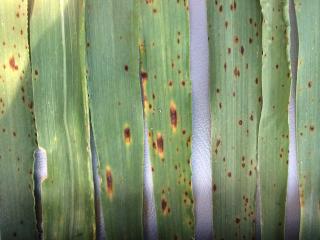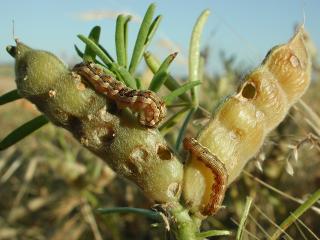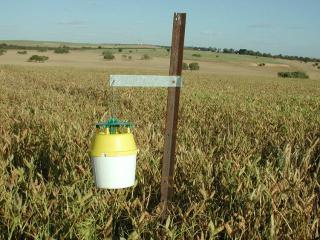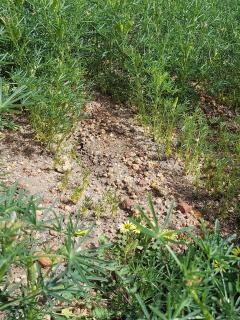Native budworm activity. Trapping has finished for the season
Caterpillar activity
- Williams
- Tambellup
Plant pathologist Kylie Chambers has recently reported finding high levels of native budworm caterpillars and associated feeding damage in canola and lupin plots at a trial site at Williams.
A grower near Tambellup has reported finding budworm caterpillars in his cereals but was not too concerned given the very low amount of damage that was evident.
Entomologist Dusty Severtson (DPIRD) advises growers and consultants to identify caterpillars. If they are native budworm then sweep net and monitor damage as cereals are not a host and they are unlikely to cause economic damage. For more information refer to DPIRD’s 2019 PestFax Issue 19 article Native budworm update and likely reasons behind high numbers this season and their presence in cereal crops.
Native budworm moth trapping surveillance has concluded
Many of the volunteer farmers, agronomists and DPIRD staff who have been trapping native budworm moths this season have packed away their traps because crops are too advanced to be troubled by future moth egg laying.
Their efforts in sending in weekly reports to PestFax and providing advanced warning of the budworm threat are greatly appreciated.
The automated native budworm moth trap surveillance has also concluded for the season.
Native budworm moths generally move westward looking for less advanced crops as the eastern crops dry out, and continue migrating in search of other host plants such as pasture and vegetables.
All late maturing crops and legume pastures should be checked for budworm caterpillars, especially in areas where moth numbers have been recorded 3-4 weeks ago.
This season’s automated and manual trappings are available for viewing at the department’s Native budworm moth numbers 2019.
Be mindful of withholding periods near harvest
Farmers with native budworm caterpillars in their crops need to be mindful of insecticide withholding periods (WHP) close to harvest and remember that swathing/windrowing is classified as harvest.
For more information on insecticides refer to the department’s Winter/Spring Insecticide Spray Chart 2019.
For more native budworm moth information contact Alan Lord, Technical Officer, South Perth on +61 (0)8 9368 3758 or +61 (0)409 689 468.
Article authors: Alan Lord (DPIRD South Perth), Dusty Severtson (DPIRD Northam) and Cindy Webster (DPIRD Narrogin).
Managing rhizoctonia bare patches in lupins
Growers that have observed poor patches in their lupin crops this season are urged to diagnose and confirm the issue causing the patches in crops in order to put the right management plan in place for 2020.
Rhizoctonia bare patch (caused by the fungus Rhizoctonia solani AG8) occurs on most soil types throughout the wheatbelt and causes similar patches in all broadacre crops and pasture species, meaning that in an affected paddock, patches will be apparent to some degree in most years.
All varieties and species of lupin are equally susceptible to rhizoctonia bare patch.
What to look for in the paddock:
- Distinct patches of stunted or dying lupin plants that start to show in seedlings 4-6 weeks after sowing.
- Patches are roughly circular with a diameter varying from 0.5m to 5m that may be elongated in the direction of sowing.
- Almost no yield within the patches.
- Weeds within the patch are usually also affected.
Plant symptoms;
- Tap and lateral roots of stunted plants are pinched off by characteristic dark brown – black spear-tipped lesions. Roots may look stubby when soil is still attached.
- As the season progresses damaged plants often die.
Rhizoctonia bare patch can be confused with Eradu patch in lupins as it also causes patches of stunted and dying plants. However, Eradu patch causes brown lesions that strip the root cortex and also pinch root ends, rather than dark brown spear tip pinched roots. Eradu may become apparent slightly later than barepatch and does not affect broad-leafed lupins, wheat or canola (so patches are not evident in other phases of the rotation).
For diagnosis of root disease or nematode problems in-crop, growers and consultants can carefully dig up symptomatic plants from the edge of the patch (not the centre) as well as healthy plants from outside the patches. The department’s YouTube video How to take a plant sample shows the correct method to use. Plants can be sent to the department’s Diagnostic Laboratory Services, Department of Primary Industries and Development, Reply Paid 83377, 3 Baron-Hay Court, South Perth WA 6151.
Managing rhizoctonia bare patch
Tillage to a depth of 10-15cm at about the time of sowing reduces the number and severity of patches. Modification of seeding machinery to cultivate 5-10cm below the sowing depth will provide effective disease control in direct drilled crops
Patches can also be controlled by deep ripping (25-30cm) immediately before or after seeding.
Rhizoctonia bare patch has a wide host range but not all crops increase the pathogen inoculum to the same extent. Levels of rhizoctonia inoculum in the soil will be highest after cereals, especially barley, and lowest after canola. Canola can reduce levels of the pathogen and reduce disease significantly in the subsequent cereal crop.
Significant summer rainfall after harvest with good weed control can reduce rhizoctonia levels in the soil.
Seed or in-furrow fungicides are not yet registered for control of rhizoctonia bare patch in lupins. However, there are cereal registrations for seed and in-furrow fungicides which can be used in the cereal phase to manage rhizoctonia bare patch.
Keeping disease inoculum levels at low levels is the most effective way to minimise crop losses from root diseases and this can be achieved by thinking long-term and implementing management practices over more than one cropping season.
If you have confirmed your paddock has rhizoctonia with large amounts of the crop affected this year, the best option would be to place the paddock into a grass-free break crop in 2020, such as canola. Canola has been shown to reduce the level of disease in the following cereal crop.
For detailed information about management options for rhizoctonia refer to the GRDC's Tips and Tactics Rhizoctonia factsheet.
For more information see DPIRD’s Diagnosing rhizoctonia bare patch in grain legumes page.
For more information contact Daniel Hüberli, Plant Pathologist, South Perth on +61 (0)8 9368 3836 or Geoff Thomas, Plant Pathologist, South Perth on +61 (0)8 9368 3262.
Article authors: Cindy Webster (DPIRD Narrogin), Daniel Huberli (DPIRD South Perth) and Geoff Thomas (DPIRD South Perth).
Ramularia leaf spot of barley – is it in your area?
Growers and agronomists in long season areas are invited to submit leaf samples to a new GRDC project assessing the distribution of Ramularia leaf spot across the Australian grain belt.
Ramularia leaf spot of barley is a newly identified fungal disease for the Australian grains industry that can be a problem later in the season. This disease was found in Tasmania in 2016 and in southern WA in 2017.

Ramularia can be easily confused with elongated spot-type net blotch (STNB) or net-type net blotch (NTNB). Initially these blotches start as pepper spots, then develop into dark brown blotches that are highly rectangular, restricted by leaf veins, reddish brown with yellow margins and penetrate to the other side of the leaf.
Foliar fungicides are not currently registered for this disease in Australia, however fungicides registered for management of other diseases in barley, such as net blotches, are known to be effective for ramularia. The major concern with ramularia is its ability to become fungicide resistant relatively rapidly.
Submitting samples
To submit leaves (green or dead) for ramularia testing, up to 100 flag minus 1 leaves can be sampled randomly or growers can target leaves with potential symptoms. Please record the GPS coordinate and send leaves in a paper bag/envelope to Andrea Hills at PMB 50, DPIRD Esperance, WA 6450 and labelled “Ramularia survey” with your name and contact details.
For more information refer to the DPIRD’s Look out for leaf spot in Western Australia page and GRDC’s Groundcover article High-rainfall growers warned to watch for ramularia leaf spot during season.
For more information contact DPIRD plant pathologists Andrea Hills, Esperance on +61 (0)488 575 091 or Kithsiri Jayasena, Albany +61 (0)8 9892 8477.
Article authors: Andrea Hills (DPIRD Esperance) and Cindy Webster (DPIRD Narrogin).
Are you participating in DPIRD’s Biosecurity Blitz?
Growers and consultants across WA still have time to sign up and participate in DPIRD’s annual Biosecurity Blitz, which started on 19 October and runs to 16 November.
This is the fifth year of the Biosecurity Blitz that invites communities across Australia to get outdoors to look for insects, animals, weeds, aquatic pests and signs of disease, which could impact Western Australia’s valuable agriculture and fisheries industries.
The aim is to discover, photograph and record as many interesting or damaging pests as possible while raising awareness about the importance of biosecurity.
At the end of the first week of the blitz an impressive 298 MyPestGuide™ reports had been submitted.
The initiative has proven valuable in delivering essential information to verify Australia’s freedom from exotic pests and, in turn, maintain Australia’s ability to continue trading and grow access to future markets.
To participate in the Biosecurity Blitz, all you need to do is:
- Sign up
- Download one of our free reporting apps, which include the free MyPestGuideTM Reporter or PestFax apps, as well as the WA PestWatch app for aquatic observations
- Make reports until the 16 November
- Try out one of the survey activities. There is even a liver fluke activity.
DPIRD experts will identify the organisms reported and map the data online for the reporting community to view.
Report information is combined with other WA surveillance data collected in collaboration with the public to help verify whether WA has certain unwanted pests.
For more information visit the Biosecurity Blitz frequently asked questions page or contact the MyPestGuide Team.





